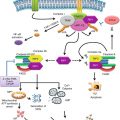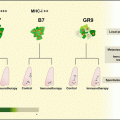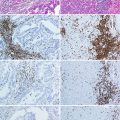© Springer-Verlag Berlin Heidelberg 2015
Nima Rezaei (ed.)Cancer Immunology10.1007/978-3-662-44006-3_11. Introduction on Cancer Immunology and Immunotherapy
(1)
Department of Immunology, Research Center for Immunodeficiencies, Children’s Medical Center, Pediatrics Center of Excellence, Tehran University of Medical Sciences, Dr Qarib St, Keshavarz Blvd, Tehran, 14194, Iran
(2)
Department of Immunology, School of Medicine, and Molecular Immunology Research Center, Tehran University of Medical Sciences, Dr Qarib St, Keshavarz Blvd, Tehran, 14194, Iran
(3)
Thoracic and Cardiovascular Surgery, Department of Surgery, College of Medicine, University of Florida, Gainesville, Florida 100129, USA
(4)
Research Center for Immunodeficiencies, Children’s Medical Center, Tehran University of Medical Sciences, Tehran, Iran
(5)
Department of General Surgery and Immunology and Microbiology, Rush University Medical Center, Rush University Cancer Center, Chicago, IL 60612, USA
1.1 Introduction
1.2 Cancer Immunity
1.5.2 Cancer Immunodiagnosis
1.6 Cancer Treatment
1.6.1 Cancer Immunotherapy
1.6.2 Cancer Cell “Switch”
1.1 Introduction
Cancer is a life-threatening disease, which can involve all human organs and tissues. It is the second leading cause of death and is responsible for 25 % of all deaths in the United States. In 2012, more than 1.6 million new cases (848,170 men and 790,740 women) of invasive cancers were diagnosed in the United States alone [1]. The major cancers in adults include lung, breast, prostate, and colorectal cancer. In addition, 60,824 adolescents and young adults aged 15–29 years old were diagnosed with invasive cancers between 1975 and 2000 [2]. Among all invasive cancers, lymphoma was the most common cancer (20 %), followed by invasive skin cancer (15 %), male genital system cancer (11 %), and endocrine system cancer (11 %) [2]. Although cancer incidence has increased among people younger than 45 years old during 1975–2000, overall cancer incidence has decreased in men by 0.6 % per year during 2004–2008. Remarkably, the rate remained stable among females due to the high rate of breast cancer [3].
Many cancer predisposing factors have been recognized; it has been found that cancer incidence is significantly associated with age from 10 to 60 years. Additionally, male gender is at higher risk of developing cancer compared to females [2]. Race is another important factor for cancer development; before 40 years of age, non-Hispanic whites and, after 40 years of age, African-Americans/blacks have the highest incidence [4]. Other risks factors include life style choices such as tobacco use, obesity, and lack of exercise and environmental factors such as exposure to excessive sun, radiation during childhood, human papilloma virus (HPV), human immunodeficiency virus, and Epstein-Barr virus (EBV) infection [4].
Cancer can be a life-threatening health problem, especially when the tumor has metastasized to other organs. It is estimated that 577,190 patients (including 301,820 men and 275,370 women) died from cancer in the United States in 2012. Four cancers – lung and bronchus, prostate, and colorectal in men and lung and bronchus, breast, and colorectal in women – are responsible for approximately 50 % of cancer-related deaths. Fortunately, the overall cancer-related mortality has been decreasing in recent years. The death rate decreased by 1.8 % per year among men and 1.6 % per year among women. The highest mortality reduction has been found among African-Americans (2.4 % per year), followed by Hispanics (2.3 % per year); however, American Indians/Alaska natives were an exception, and the rate remained unchanged in this population [1].
Cancer survival significantly impacts patients’ quality of life. Five-year mortality rates depend on several factors; survival is worse among males over 30 years of age, and the survival gets worse for patients over 45 years old in both males and females. Non-Hispanic whites have the best survival rate and African-Americans have the worst survival with survival differences as great as 20 % at 5 years after cancer diagnosis [5]. Furthermore, the type of cancer is another risk factor for patient survival. Total mortality rates vary from 6 % in thyroid cancer to 97 % in pancreatic cancer [6].
1.2 Cancer Immunity
Cancer immunology has been studied for a long time; however, the molecular and cellular basis of tumor immunity is not completely understood. Advances in understanding the basis of immunosurveillance and progress in the treatment of infectious disease have had a major impact on the development of tumor immunotherapy. The modern era of tumor immunology began in the 1950s when the role of T cell responses in tissue allograft rejection was initially identified. Since then, it has been confirmed that tumors occur in association with impaired function of T cells, indicating the importance of the immune system in the development and progression of cancer [7]. The identification of tumor-associated antigens, knowledge of effector T cell responses, and the role of regulatory and suppressor T cell populations are now shaping the use of the immune system to treat cancer.
In addition to an improved understanding of the immune system, significant advances in understanding the molecular basis of neoplasia have occurred. Precise control of cellular activity and metabolism is crucial for proper physiologic function. Notably, cell division is an important process that requires precise regulation. The main difference between tumor cells and normal cells is lack of growth control during the cell division process. This uncontrolled cell division can originate from various factors, such as chemical agents, viral infections, and mutations that lead to escape of cells from the checkpoints which properly control cell division. According to the type of tumor and proliferation rate, cancers can be benign or malignant [8]. It has been found that some tumors are caused by oncogenic viruses that induce malignant transformation. These oncogenic viruses can be both RNA and DNA viruses. Also, viral infection may lead to leukopenia and immunodeficiency, increasing the risk of malignancy. Therefore, prophylactic immunization against oncogenic viruses (such as EBV, HPV, and HBV) might be a logical strategy for prevention of malignancy [9]. Indeed, a vaccine against the human papilloma virus has shown significant impact on preventing cervical intraepithelial neoplasia and may prevent development of cervical carcinoma.
1.3 Cancer and Immune System Impairment
It has been reported that impaired immune response can induce tumor growth and prevent effective antitumor suppression, possibly through a process of “sneaking through” which allows improved growth of small tumors rather than large tumors [10]. Tumors may also produce immunosuppressive factors, such as interleukin-10 (IL-10), transforming growth factor-β (TGF-β), and alpha-fetoprotein, which suppress innate immune responses against cancer. This has led to investigations using neutralizing antibodies against these immunosuppressive factors [7]. In contrast, tumor-specific cytotoxic T lymphocytes (CTLs) can be genetically altered to become resistant to the TGF-β inhibitory effect by transgene expression of a mutant dominant-negative TGF-ß type II receptor (DNR). In addition, specific T cells genetically manipulated to produce IL-12 can overcome the inhibitory effects of IL-10. On the other hand, tumors may express FasL and stimulate apoptosis of tumor-infiltrating effector T cells. Small interfering RNA (siRNA) can be used to knock down the Fas receptor in tumor-specific CTL, leading to a significant decrease in their susceptibility to Fas-/FasL-mediated apoptosis [11].
The interaction between the immune system and established cancers is complex, because in addition to increasing carcinogenesis by various carcinogens among compromised subjects, cancer cells themselves can lead to severe immunosuppression. It has been reported that patients involved with primary immunodeficiency syndromes have higher risk of cancer development. In a report by Kersey et al., subjects that had an inherited abnormal lymphoid system were susceptible to malignant transformation and impairment of tumor immunosurveillance [12, 13]. In addition, tumors produce soluble factors which downregulate the interleukin-2 receptor-α (IL-2Rα), leading to suppression of T cell function. Furthermore, established tumors may result in severe protein expenditures in hosts, contributing to impairment of immune system function [14].
1.4 Immune System Reaction to Cancer
A critical question is whether cancer cells are sufficiently different from their normal cellular counterparts, and can thus be recognized by the immune system. The immune system also produces a group of complementary markers with protective effects against cancer and other immunologic or inflammatory stresses. These markers include proteins released by T cells and are generally classified as “cytokines.” Cytokines include interleukins, interferons, tumor-necrosis factors (TNF), and lymphocyte-derived growth factors. The production of tumor-specific antibodies and/or activation of tumor antigen-specific T cells target tumor-associated antigens typically found on the cell membrane. Studies have suggested that vaccination in the presence of complements can lead to tumor lysis. While incompletely defined, several soluble and cellular mediators of tumor rejection have been described, including complement factors, active macrophages, T cells, and NK cells. While T cells require antigen specificity, the soluble and cellular mechanisms of the innate immune response can recognize the malignant phenotype in the absence of antigen specificity [15].
Since most tumor-associated antigens are self-proteins, the immune response is largely weak and patients may develop immune tolerance to tumor-associated antigens. Furthermore, the cells of the immune system may not adequately penetrate to the internal tumor microenvironment, resulting in slower immune-mediated tumor elimination. However, it is possible that the immune system may be more effective in controlling tumor growth rate rather than tumor regression [10]. Recently, it has been found that nutrition also plays a crucial role in protection against human cancer, and normal levels of zinc are required for protection against the detrimental effects of various immunosuppressive cytokines [16].
1.5 Genetic and Environmental Carcinogenesis
It has been found that genetic factors are as important as environmental carcinogens. Trials have tested carcinogenesis of retrovirus infection between different breeds of animals. A unique carcinogen resulted in disparate outcomes among different breeds, indicating the importance of genetic background in the progression of cancer. Environmental factors may also suppress immune responses and dysregulate immunosurveillance mechanisms [17].
1.5.1 Cancer Cells Escape from Host Immunosurveillance
Antigens that distinguish tumor cells from normal cells depend on the histologic origin of the tumor. Tumor-associated antigens may be viral in origin, represent mutated self-antigens, be cancer-testis antigens which are expressed only by tumor cells and normal testes, or be normal differentiation antigens. Thus, tumor cells may express similar antigens to normal cells, allowing tumor cells to escape immune system attack through induction of innate and/or peripheral tolerance. A corollary to this is that immunotherapy or stimulation of immune responses to some tumor-associated antigens may lead to damage of normal tissues and organs, as exemplified by the development of autoimmunity induced by anti-CTLA-4 or anti-PD1 monoclonal antibody (mAb) treatment [18].
A number of complex mechanisms have been suggested for the escape of cancer cells from host immunosurveillance. Tumors alter their characteristics by decreased expression of immunogenic tumor-associated antigens, MHC class I molecules, beta2-microglobulin, and costimulatory molecules, which mediate the activation of T cells. Another strategy resulting in failure of tumor immunosurveillance could be the expression of very low levels of antigens, unable to stimulate an immune response. Under some circumstances, such as failure of the immune response to induce a rapid response, cancer cells may proliferate rapidly. Further strategies for escape of tumor cells from immunosurveillance are based on inhibitory tumor-mediated signaling by CTLs, as occurs through changes in cell death receptor signaling. Other strategies which allow tumor cells to evade the immune system are the secretion immunosuppressive molecules dampening tumor-reactive effector T cells and the induction of regulatory and/or suppressor cells [19].
Stay updated, free articles. Join our Telegram channel

Full access? Get Clinical Tree







